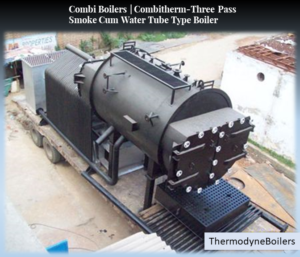Combi Boiler – Combitherm:
Combitherm boiler or is known among others as Combi boiler is a unique water cum smoke tube type design. It is the combination of both Water Tube Boiler and Smoke Tube Boiler where some tubes form the enclosed part of the external furnace in which water flows and rest of the tubes are placed in a shell in which flue gases flow.
Since the furnace is enclosed with the water tubes on 5 sides, it is the high-temperature zone where the radiation heat transfer takes place and the convection heat transfer takes place in a shell where water is filled in a shell and flue gases are flowing at high velocity in tubes.
Moreover, our membrane tubes design in case of Combitherm boilers/Combi Boilers is such that there are little or no losses to the environment and tubes also provide the high heat transfer area thereby increasing the radiation heat transfer.
Also Read: What is Combi Boiler?
Our shell in case of combitherm (Combi Boiler) is a 2 pass design to increase the residence time and at the same time keeping the velocity optimum to achieve high convective heat transfer. Our shell and water wall tubes provide large water & steam holding capacities to give the maximum advantage.
Combitherm (Combi Boilers)Working:
Water is fed to the boiler from a feed pipe connection. Firstly the water fills in the shell and then gets transported to the Bottom Header of water wall from the Down-comers welded to the Boiler Shell.
From here the water rises up in the tubes of water wall and gets thrown back to the boiler shell from the top header. As firing is done in the furnace, because of radiation the surface temperature of the water wall membrane rises and the water present in the tubes gets heated up and starts getting converted to steam.
Now this steam, being lesser dense (creating a natural circulation of steam-water in the system), rises up to the top header and gets to the Boiler Shell. The flue gas from the furnace (1st pass), traveling in the membrane, then enters the tube of Boiler Shell. In Boiler Shell flue gasses flow in the tube.
These Boiler Tubes are divided in 2 passes (2nd pass & 3rd Pass) where flow gas travel from both the passes and transfer heat to water through convective heat transfer. Steam coming from both the sides get collected at the top of the Boiler shell and then supplied through steam lines for the desired process application.
3 Pass Smoke Cum Water Tube Boiler design can burn a variety of fuels like Coal, Lignite, Rice Husk, Wood, Bagasse, Groundnut shells, and several other fuels thus providing you with lowest energy costs depending upon the fuel available in your area.
The large furnace grate area and furnace volume in case of Combitherm Boilers provide optimum time for fuel to get burnt. On the basis of fuel firing our Combitherm boilers can be divided into 2 types: Manual firing boiler and Automatic firing boiler.
When fuel feeding to the boiler is done manually generally in case of small capacity boilers where the amount of fuel fed to the boiler is generally less is said to be manual firing boiler and when fuel feeding is done automatically usually with the help of screw feeder, drum feeder, chain grate, pulsating grate etc. are said to be automatic firing boiler. Manual and automatic firing also depends upon the type of fuel.
Thermodyne has a vast experience in manufacturing Combi boilers that can burn almost all type of fuels.
Advantages:
- The flexibility of fuels with choice of agro waste fuels
- Combines the advantage of both water tube and smoke tube designs
- High thermal efficiency and low operating costs
- Minimum site work, low installation costs
- The higher degree of Equipment’s Reliability
- Dependable quality of components like valves, pumps, safeties & instruments
- Can be converted to liquid/gaseous fuels as well
- Heat recovery unit may be offered for enhanced efficiency
- Easy access for cleaning and inspection
Three Pass Smoke Cum Water Tube Type Boiler
A three-pass smoke cum water tube type boiler is a type of boiler that uses the heat from the combustion gases to heat water in three passes. The first pass is through the smoke tubes, the second pass is through the water tubes, and the third pass is through the economizer. This type of boiler is very efficient, as it uses the heat from the combustion gases to the fullest extent.
Working Of 3 Pass Boiler Working
A three-pass boiler is a type of steam boiler used for generating heat or steam in industrial processes. It’s designed to increase efficiency by maximizing the transfer of heat from the combustion gases to the boiler water. Here’s how it works:
First Pass: Combustion Gases
- Combustion Chamber: The process begins in the combustion chamber where fuel, often in the form of natural gas, oil, or coal, is burned to produce hot gases and flames.
- Flue Gas Flow: The hot combustion gases and smoke rise upward through the first pass of the boiler, heating the walls of the combustion chamber.
- Heat Transfer: Heat is transferred from the hot gases to the water-cooled walls of the combustion chamber. As a result, the temperature of the gases decreases, and they begin to lose heat energy.
Second Pass: Heat Transfer
- Transition to Second Pass: The partially cooled gases then flow downward or transition through a series of tubes or passages to enter the second pass of the boiler.
- Heat Exchange: In the second pass, the hot gases continue to transfer heat to the tubes or passages. These tubes are surrounded by water, and the heat from the gases causes the water within the tubes to heat up and turn into steam.
- Temperature Drop: As the heat is transferred, the temperature of the combustion gases further reduces, and the steam inside the tubes becomes hotter.
Third Pass: Final Heat Transfer
- Transition to Third Pass: The now cooler gases transition to the third pass, often moving through additional sets of tubes or passages before being released into the flue.
- Final Heat Exchange: In this final pass, any remaining heat is extracted from the gases, ensuring that as much heat as possible is transferred to the water for steam generation.
- Exhaust: After completing the third pass, the gases are considerably cooler and are released into the chimney or exhaust stack. These gases are now less energetic and have transferred a significant portion of their heat energy to the boiler water.
Benefits of Three-Pass Boilers:
The three-pass design offers several advantages:
- Enhanced Heat Transfer: The multi-pass design allows for more thorough heat transfer, increasing efficiency and reducing fuel consumption.
- Lower Emissions: Efficient combustion and heat transfer result in fewer unburned particles and reduced emissions.
- Increased Safety: The multiple passes and tubes provide a larger surface area for heat exchange, preventing overheating and potential boiler damage.
Capacity Range:
Combi Boiler or Combitherm Boiler, Membrane water wall type boiler is available in capacities from 1 TPH to 15 TPH.
Fuel:
- Coal,
- Lignite,
- Rice Husk,
- Wood,
- Bagasse,
- Groundnut shells,
- Petcoke, and several other Solid fuels
For More Video: Visit Our Channel
Also Read: Internal Furnace Top Feed Boilers
Our Other Industrial Boilers Products
Combitherm-Three Pass Smoke Cum Water Tube Type Boiler FAQ
1. What is a cum tube boiler?
A cum tube boiler is a type of boiler that uses both water tubes and fire tubes to heat water. Water tubes are tubes that carry water through the boiler, while fire tubes are tubes that carry hot gases from the fire through the boiler. This type of boiler is more efficient than a fire tube boiler, but it is also more complex and expensive.
2. What is a 3 pass smoke tube boiler?
A 3 pass smoke tube boiler is a type of boiler that uses three passes of smoke tubes to heat water. The smoke tubes are arranged in a serpentine pattern, which allows the smoke to heat the water more effectively. This type of boiler is more efficient than a single-pass smoke tube boiler, but it is also more complex and expensive.
3. What is a combipack boiler?
A combipack boiler is a type of boiler that combines a boiler and a hot water storage tank in one unit. This type of boiler is more convenient than a separate boiler and storage tank, but it is also more expensive
4. What is a water wall boiler?
A water wall boiler is a type of boiler that uses water-filled tubes to heat water. The water tubes are arranged in a wall-like structure, which allows the water to heat more evenly. This type of boiler is more efficient than a fire tube boiler, but it is also more complex and expensive.
5. What is a three pass fire tube boiler?
A three pass fire tube boiler is a type of boiler that uses three passes of hot gases from the fire to heat water. The hot gases pass through the boiler in a serpentine pattern, which allows the water to heat more effectively. This type of boiler is more efficient than a single-pass fire tube boiler, but it is also more complex and expensive.
6.What is a water tube?
A water tube is a tube that carries water through a boiler. Water tubes are made of a variety of materials, including steel, copper, and stainless steel. The type of material used for water tubes depends on the type of boiler and the operating conditions.
7. What is a water tube boiler?
A water tube boiler is a type of boiler that uses water tubes to heat water. Water tubes are tubes that carry water through the boiler, and they are arranged in a variety of configurations. Water tube boilers are more efficient than fire tube boilers, but they are also more complex and expensive.
8. What is a 3 pass boiler?
A 3 pass boiler is a type of boiler that uses three passes of hot gases from the fire to heat water. The hot gases pass through the boiler in a serpentine pattern, which allows the water to heat more effectively. This type of boiler is more efficient than a single-pass boiler, but it is also more complex and expensive.
A boiler is a device that produces steam or hot water by burning fuel. Boilers are used in a variety of applications, including heating homes and businesses, generating electricity, and industrial processes.
10. Why should I choose a boiler from a reputable manufacturer?
There are many reasons why you should choose a boiler from a reputable manufacturer. Reputable manufacturers have a proven track record of quality and customer service. They also have the resources to design and manufacture boilers that meet the latest safety standards.
Here are some of the benefits of choosing a boiler from a reputable manufacturer:
Quality: Reputable manufacturers use high-quality materials and construction techniques to ensure that their boilers are durable and reliable.
Safety: Reputable manufacturers design and manufacture their boilers to meet the latest safety standards.
Warranty: Reputable manufacturers offer warranties on their boilers to protect you in case of problems.
Customer service: Reputable manufacturers have a team of customer service representatives who are available to help you with any questions or problems you may have.
Thermodyne Industrial Boiler Manufacturer
- Boiler Losses That Eat Away Your Profits
- Dissolved Gases in Feed Water and Its Effect
- Pressure Reduction System
- How to minimize the Blowdown Losses

